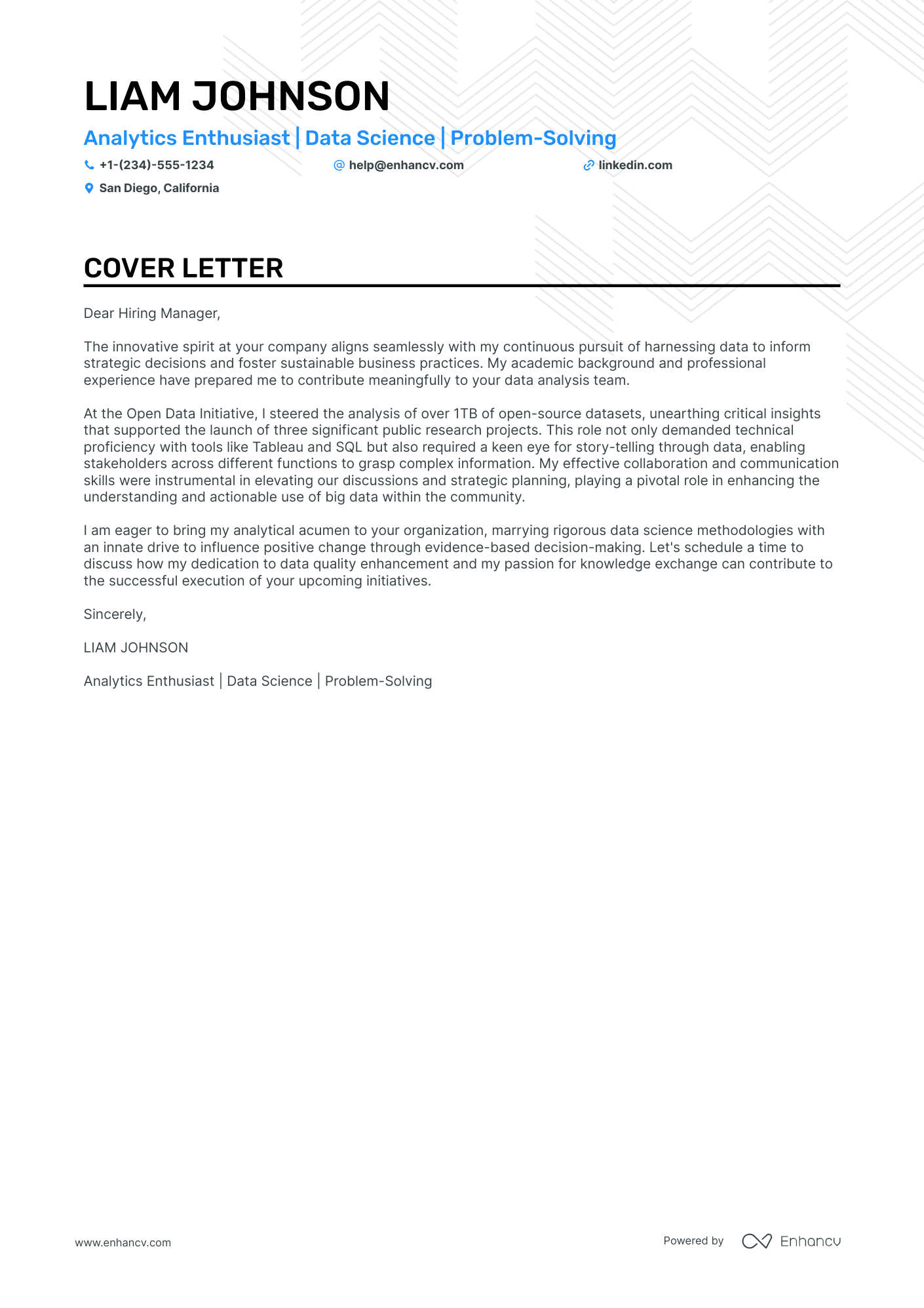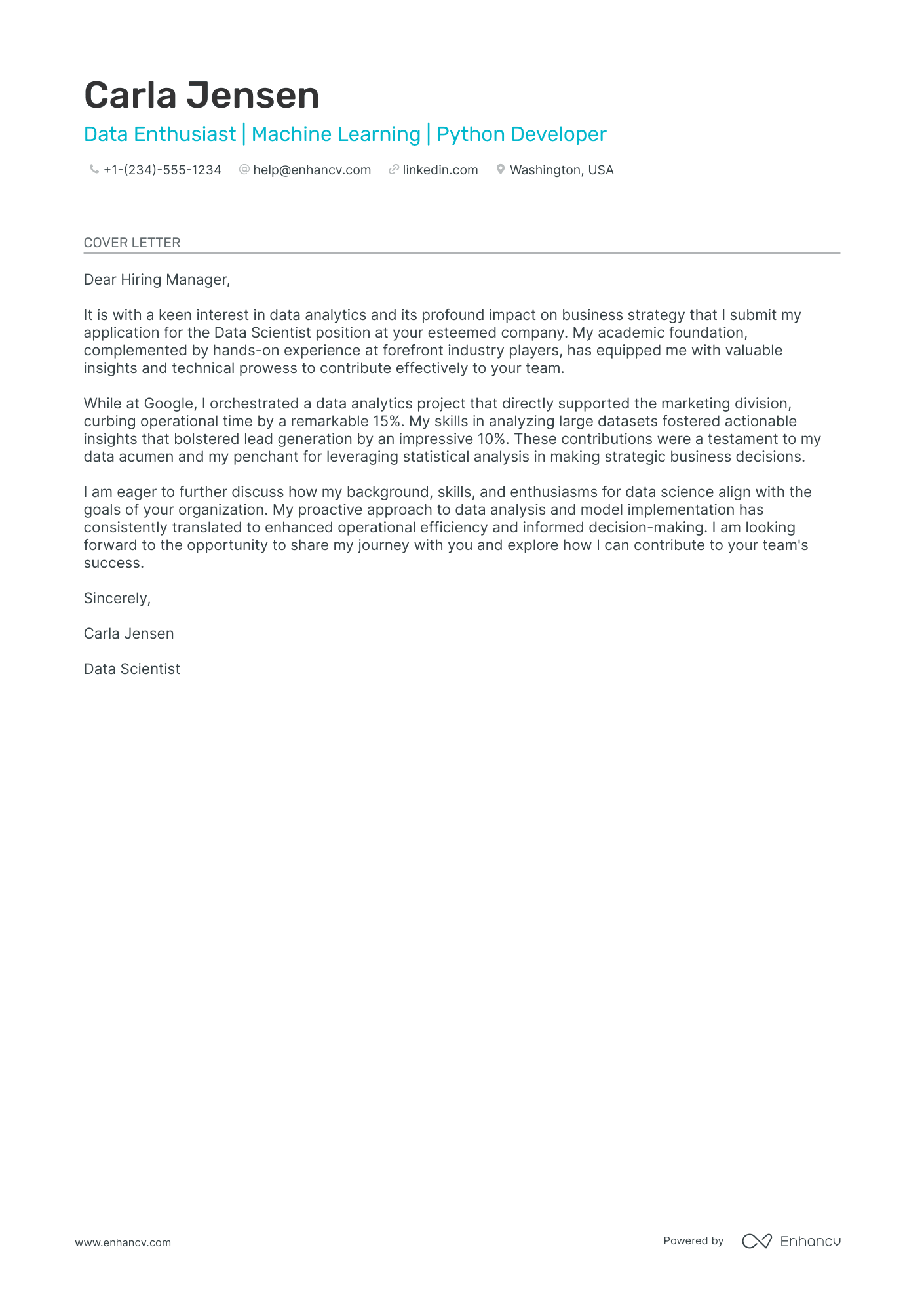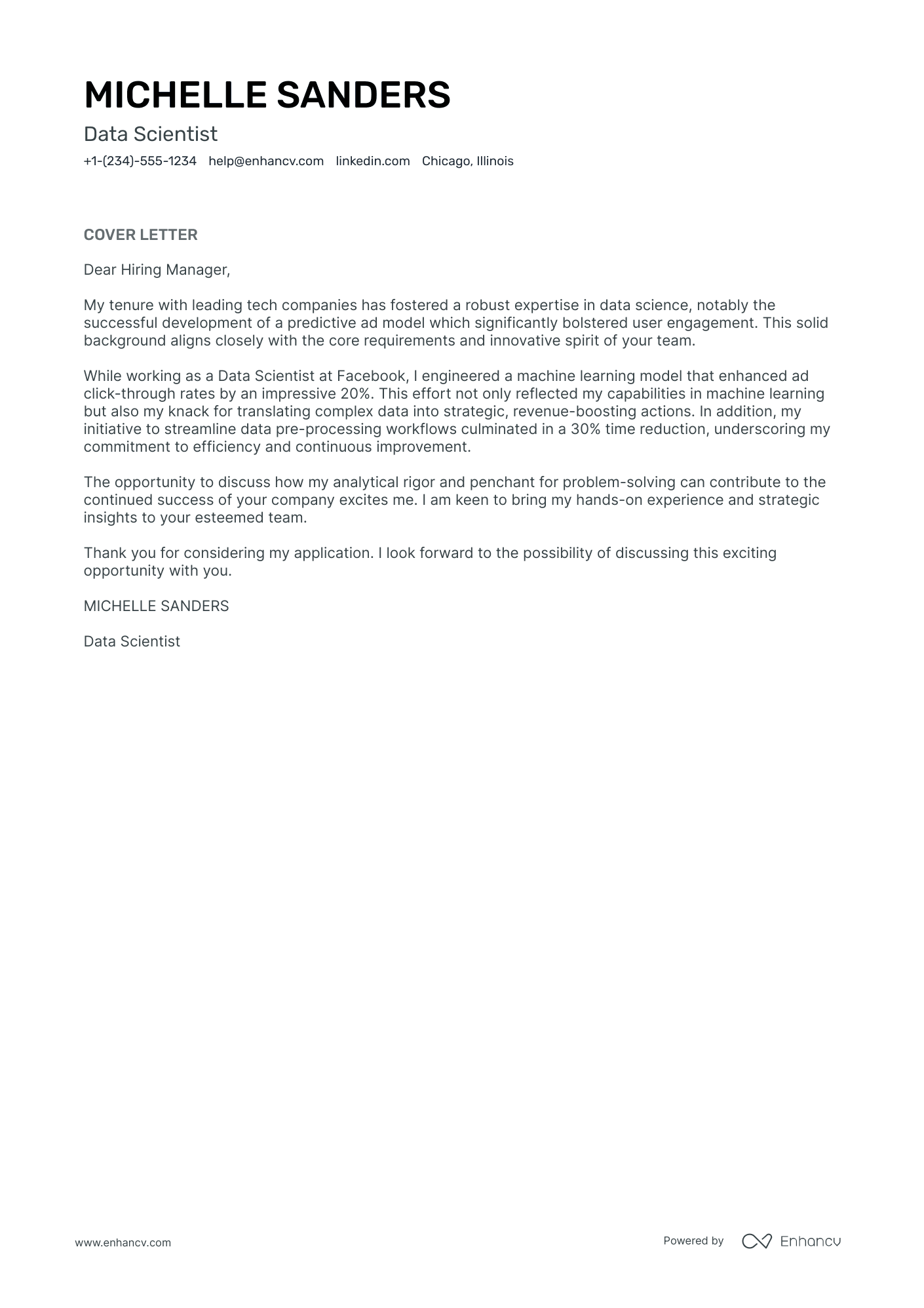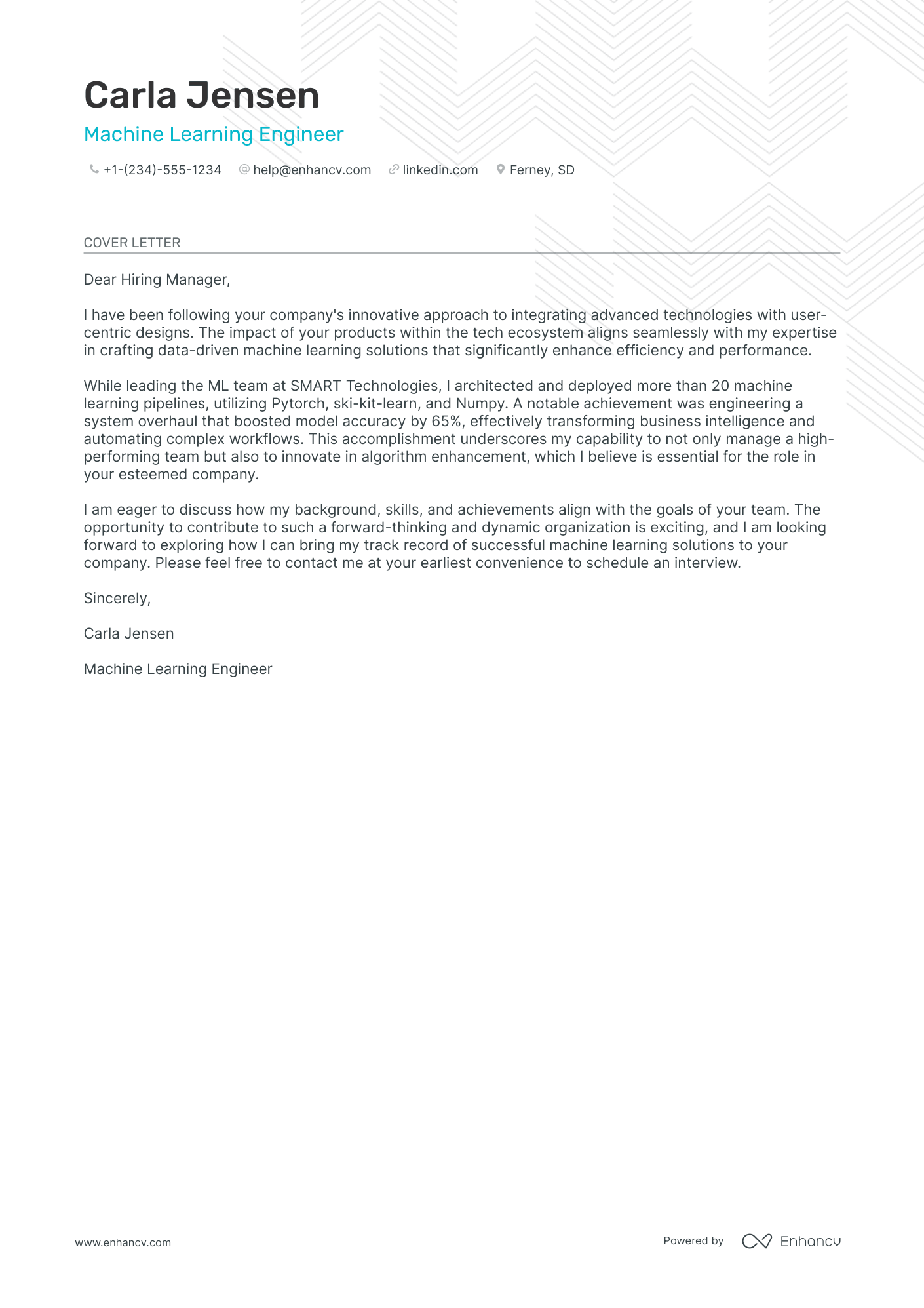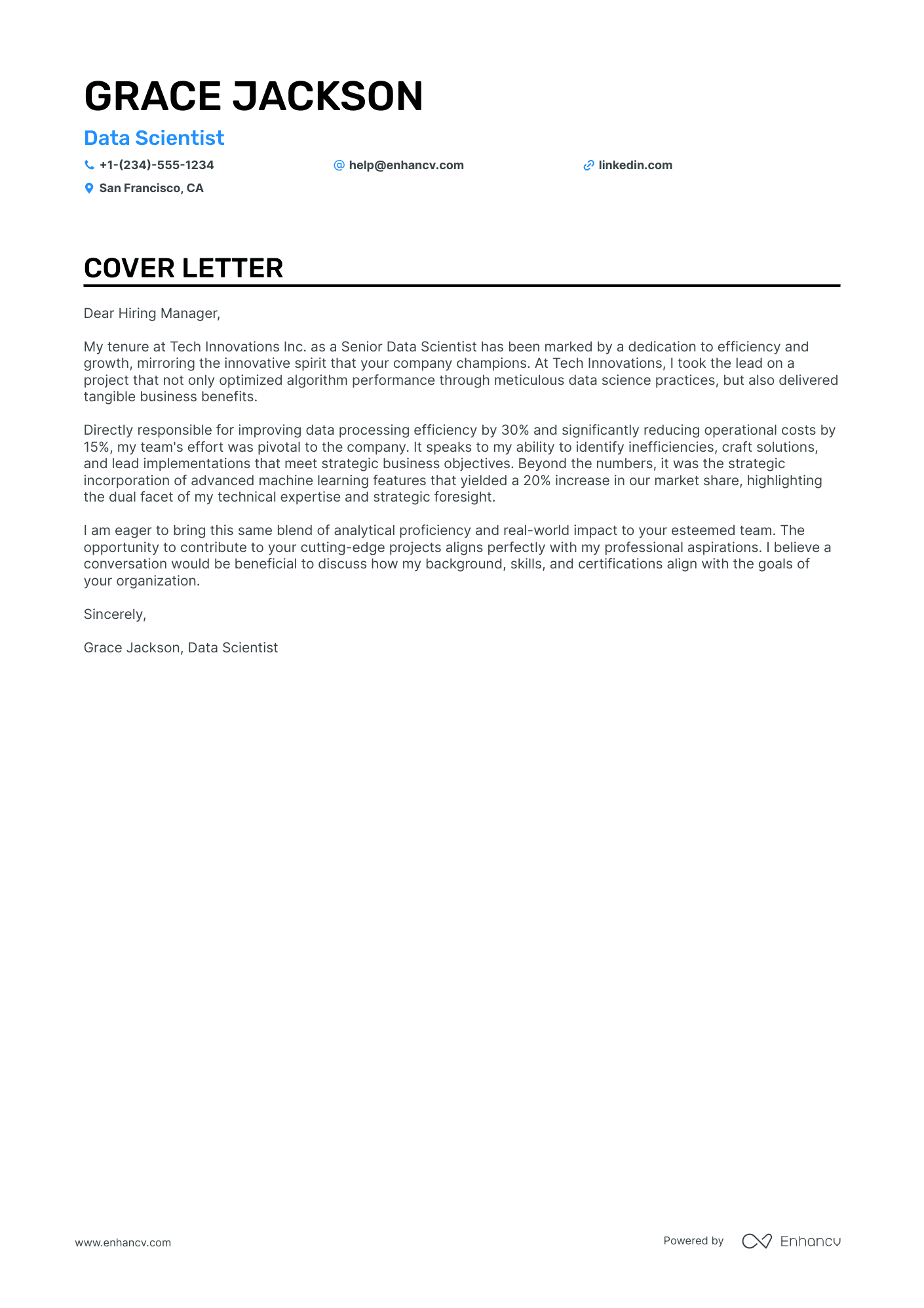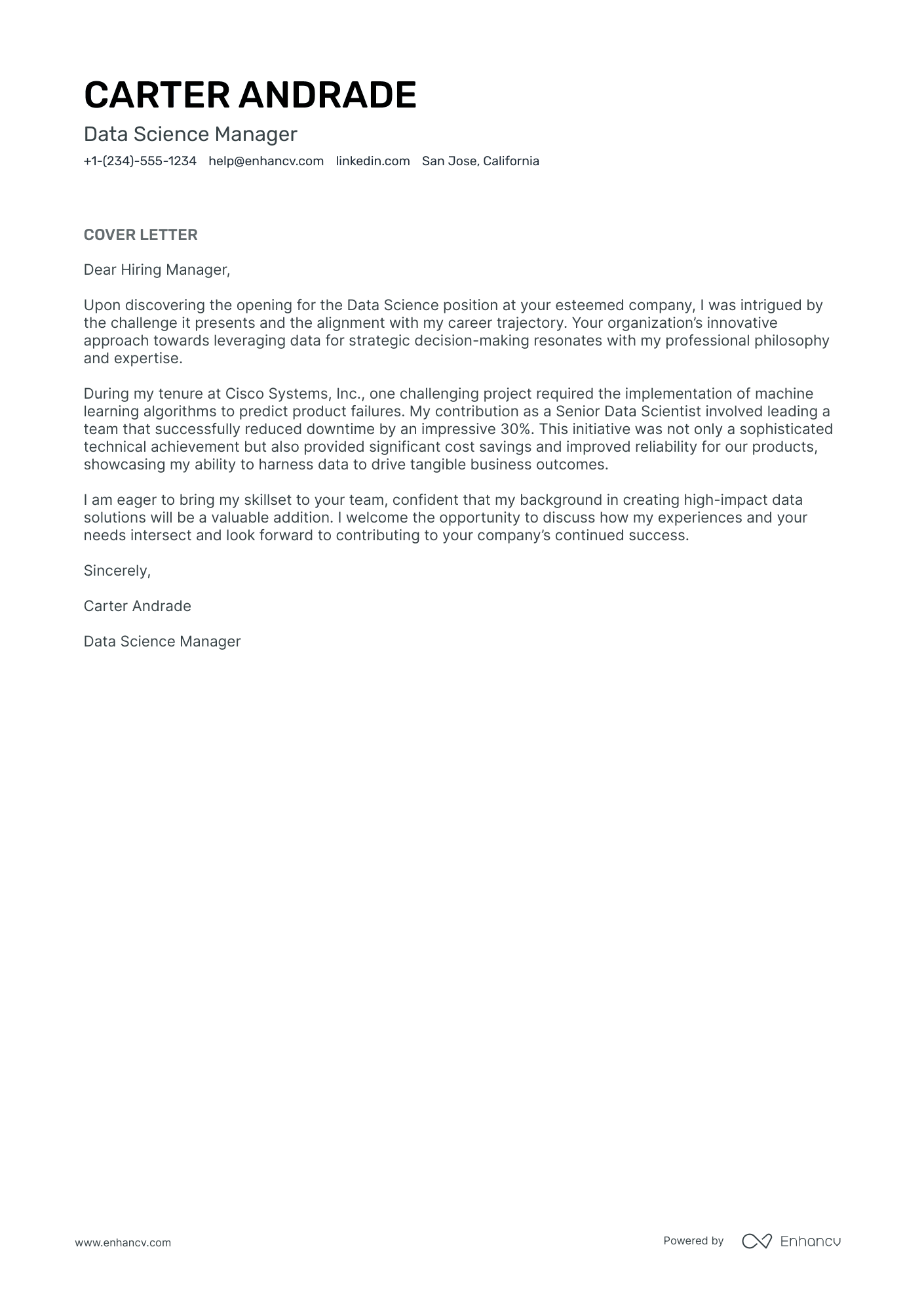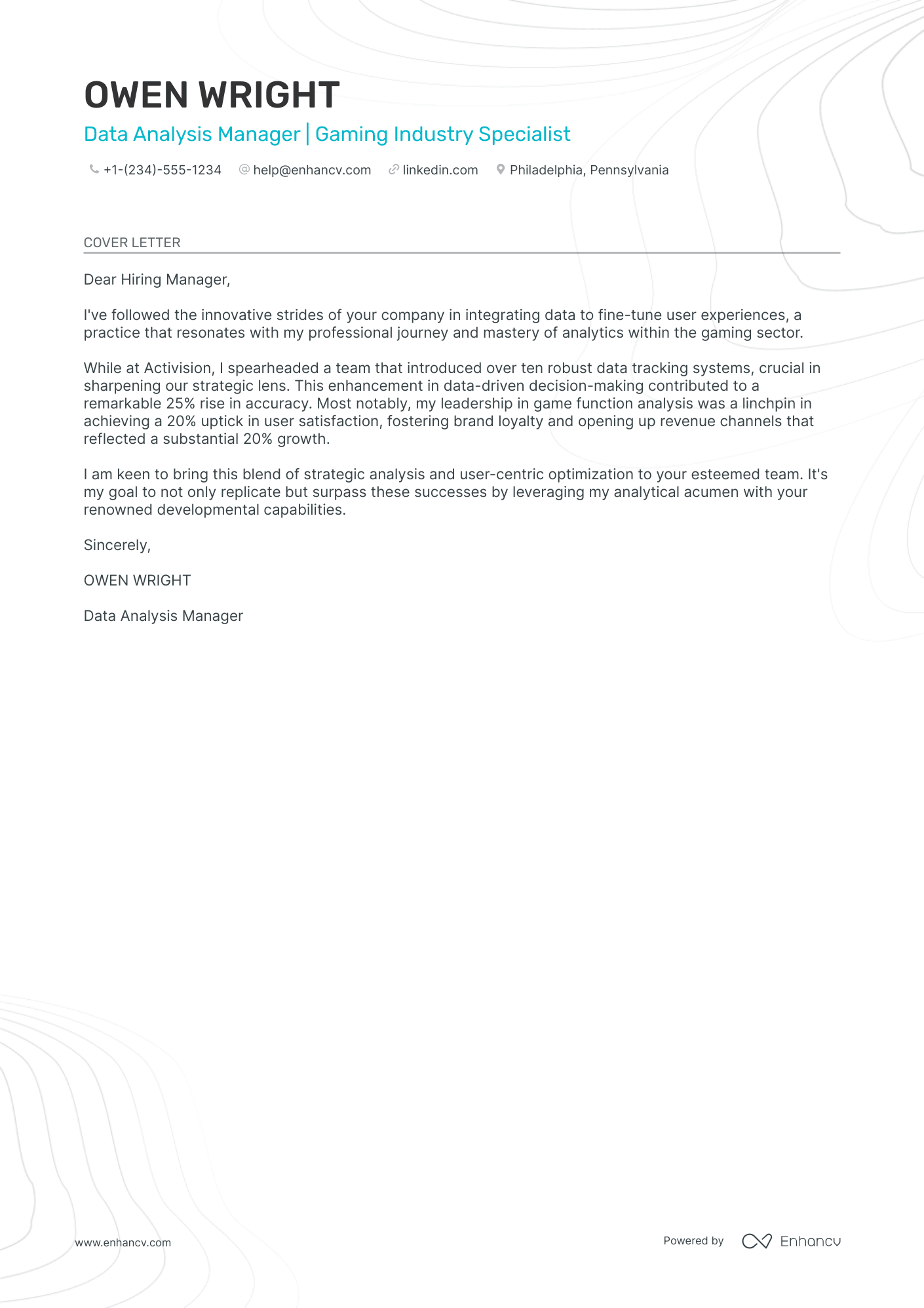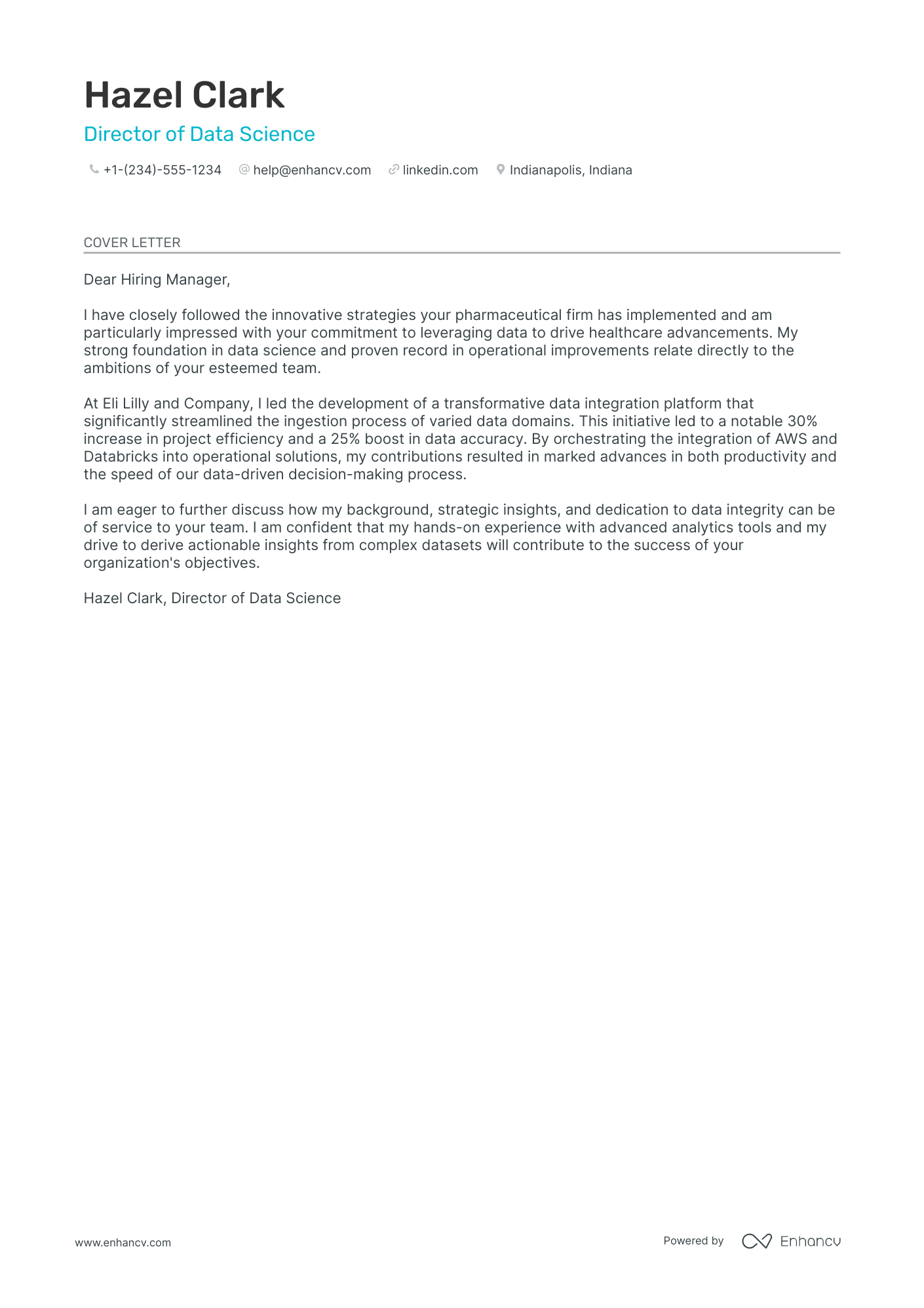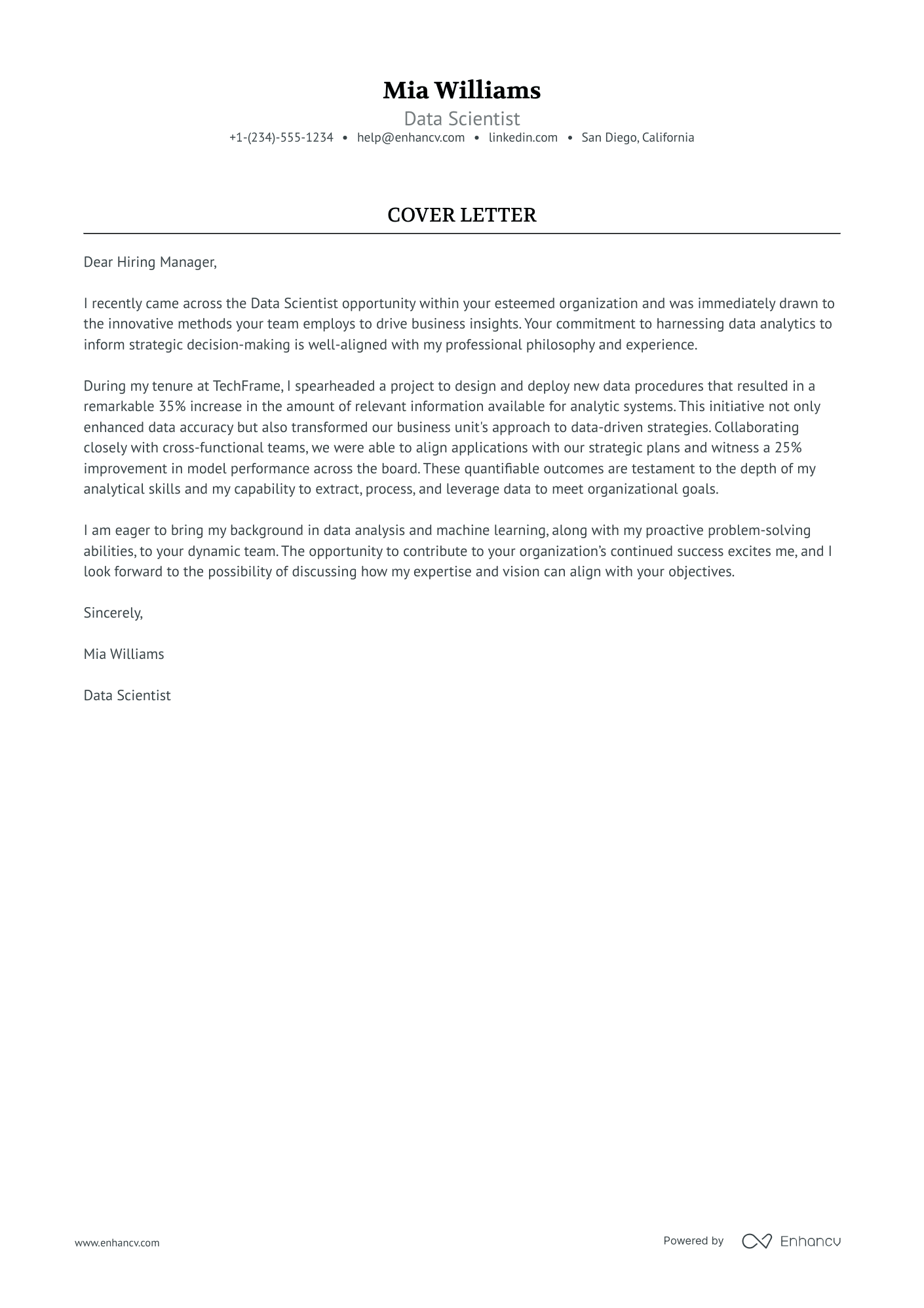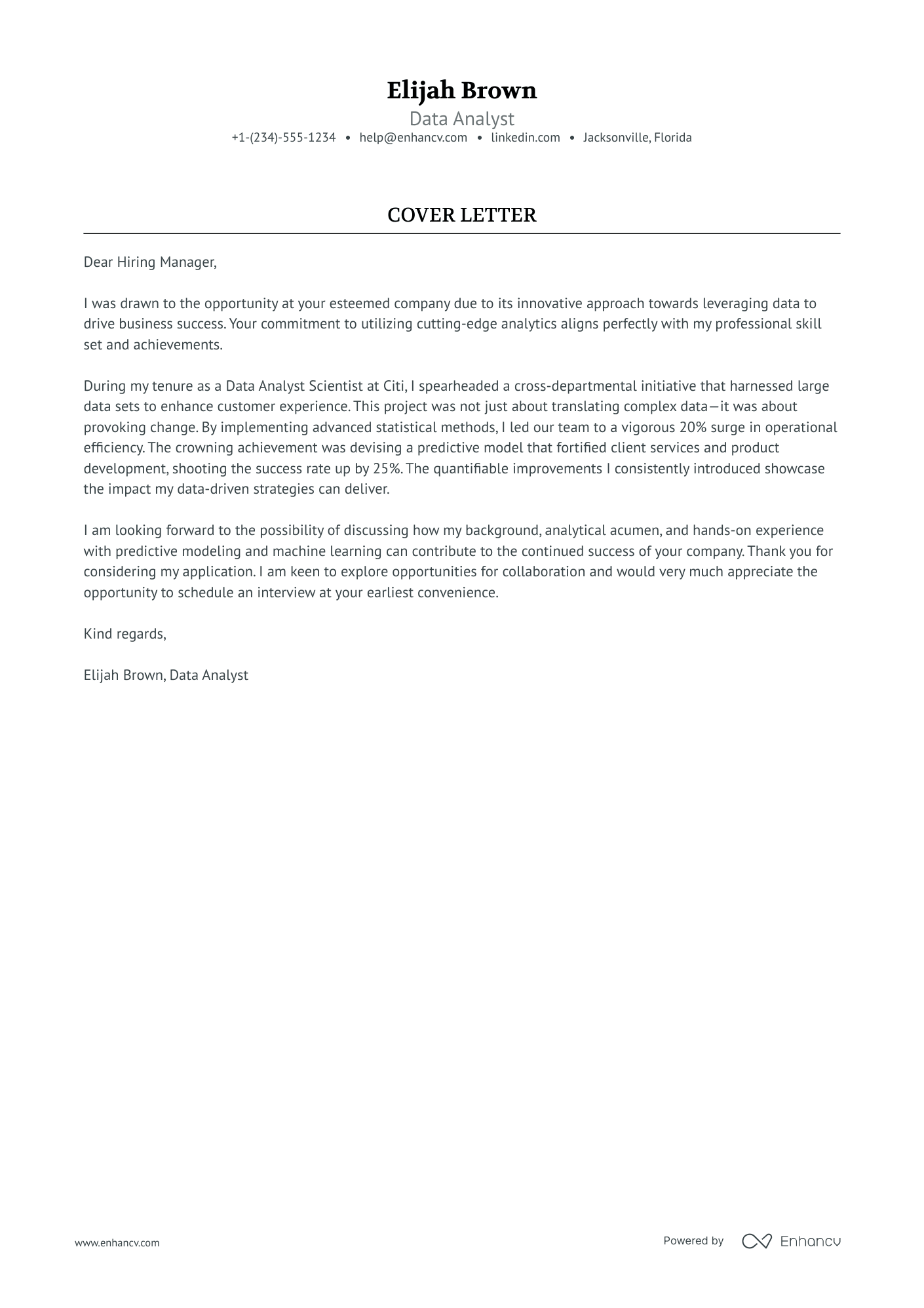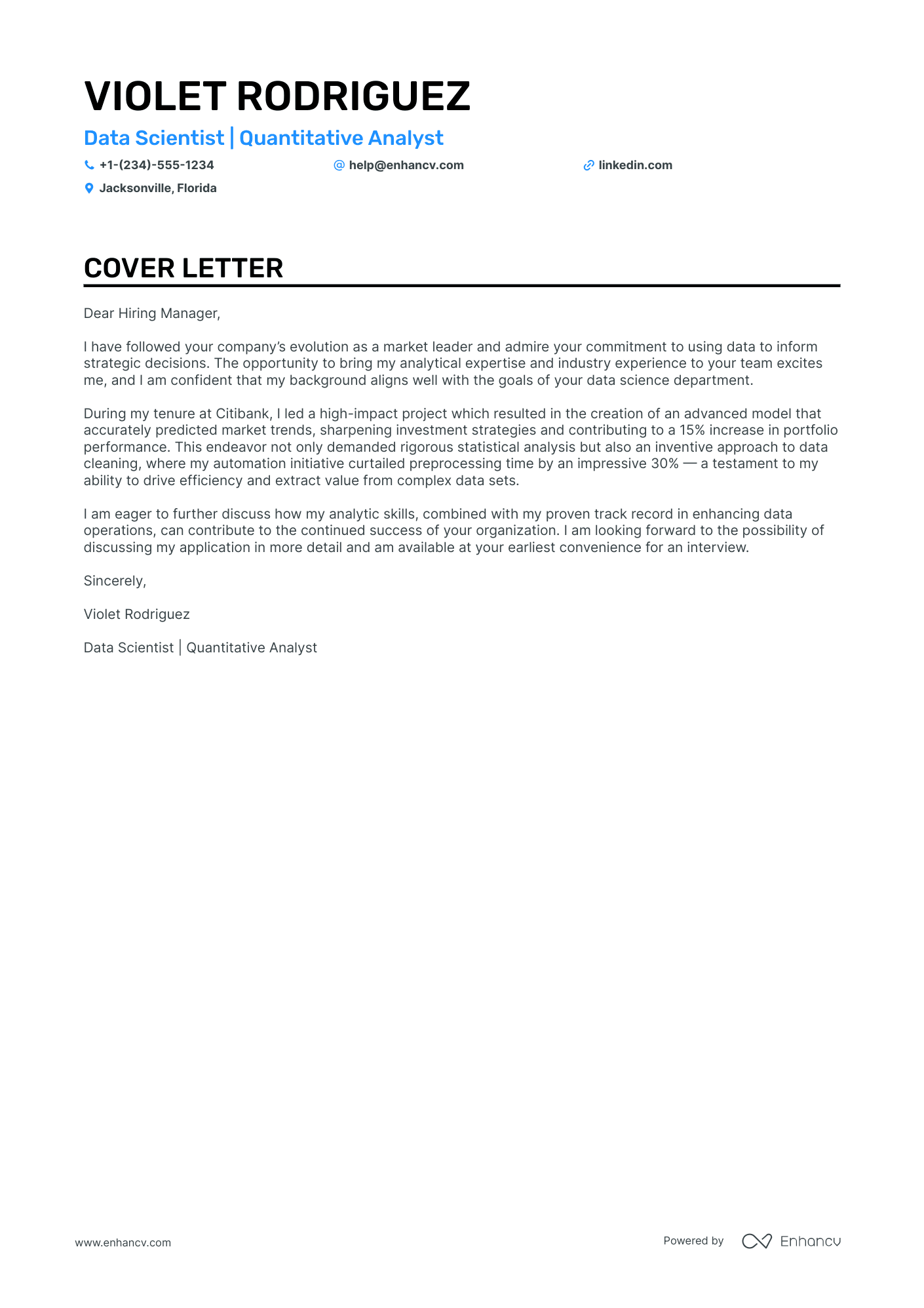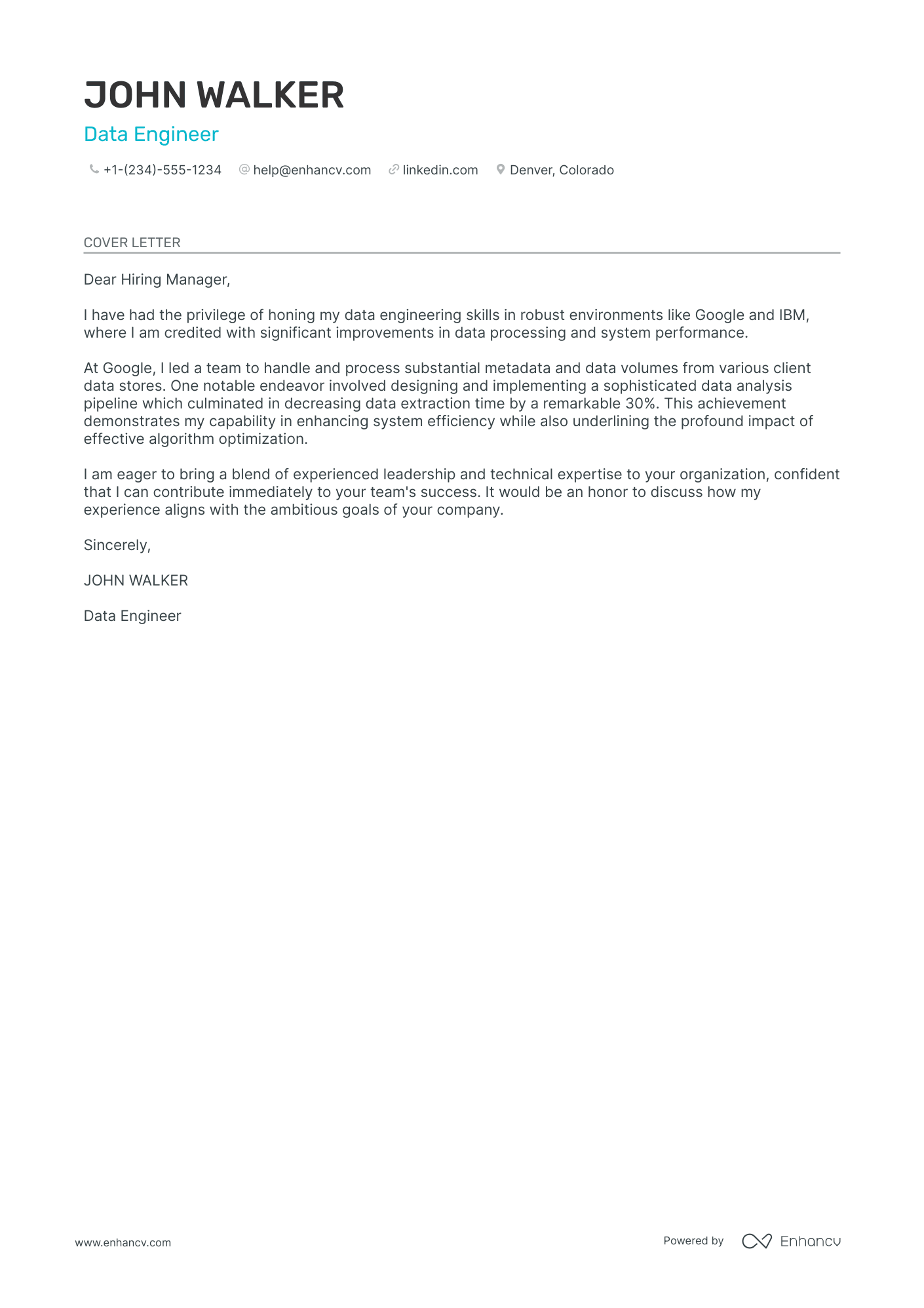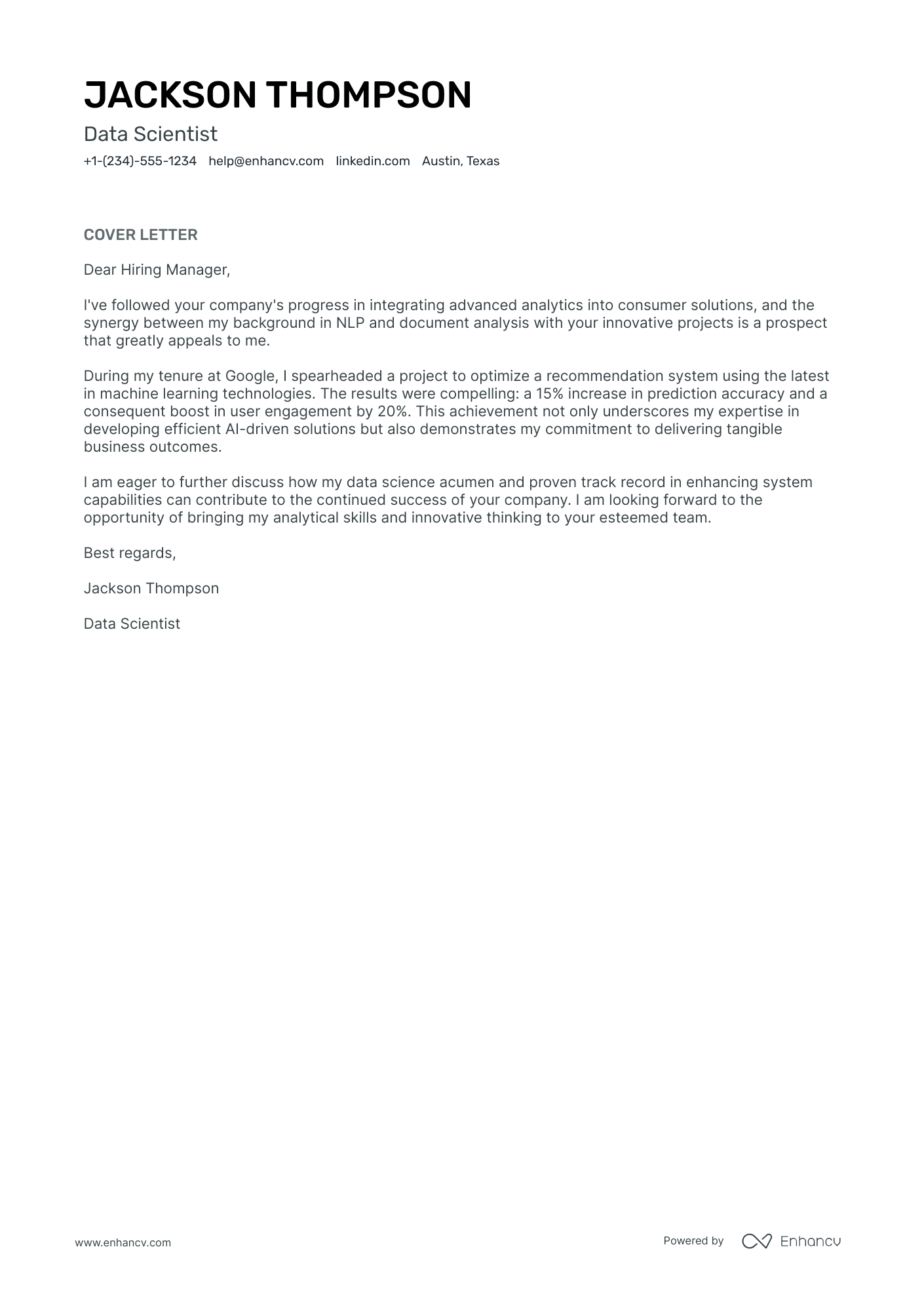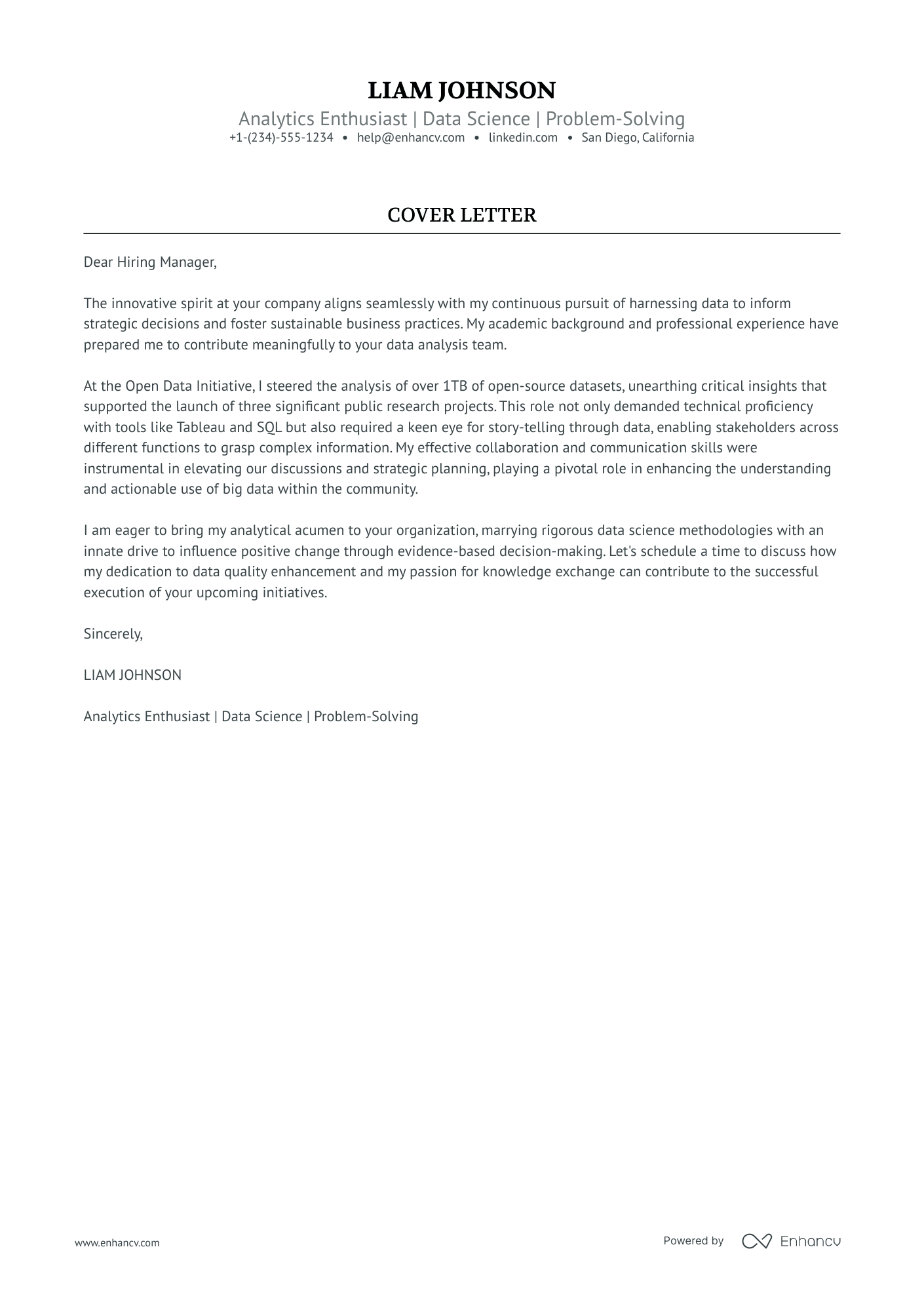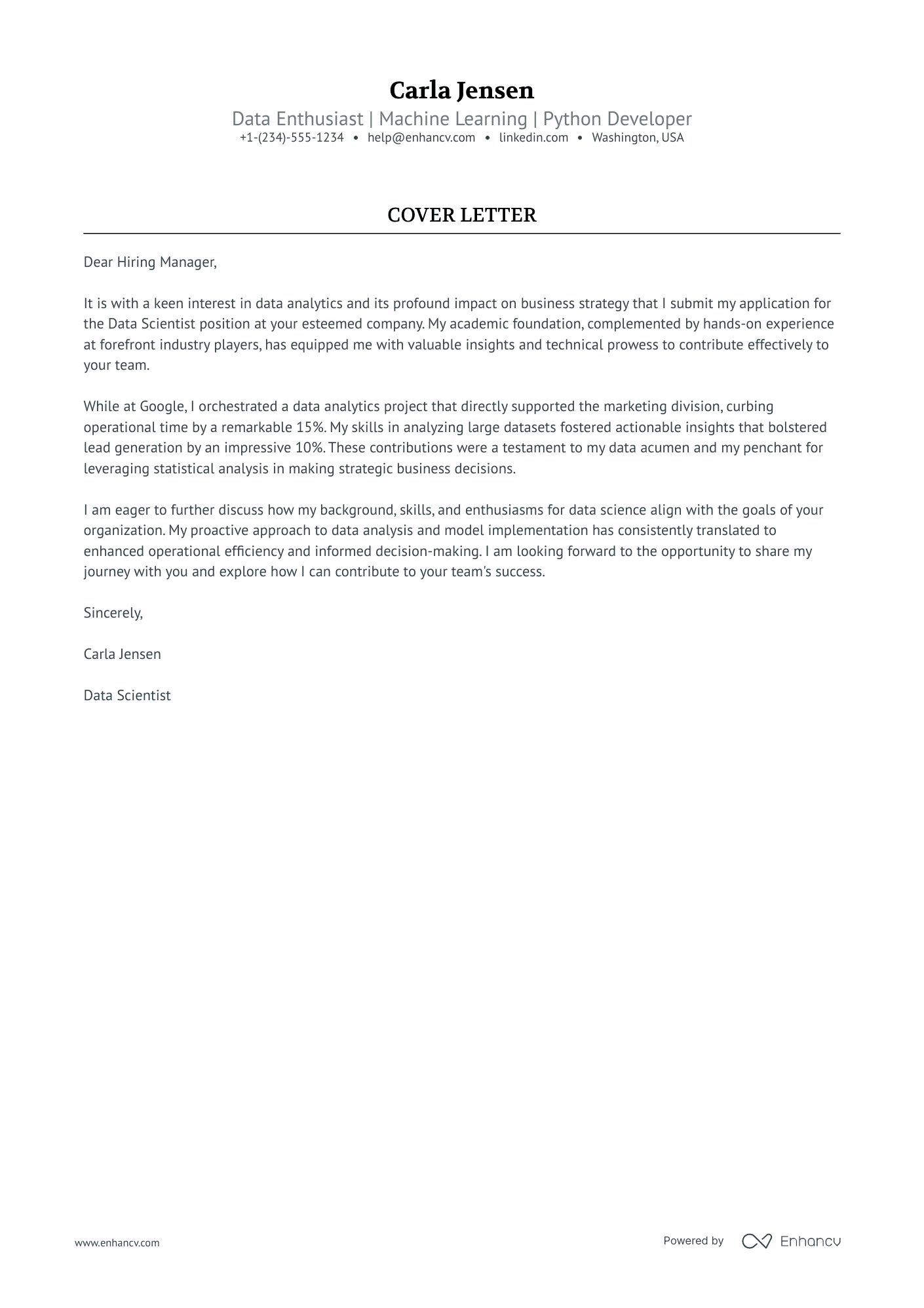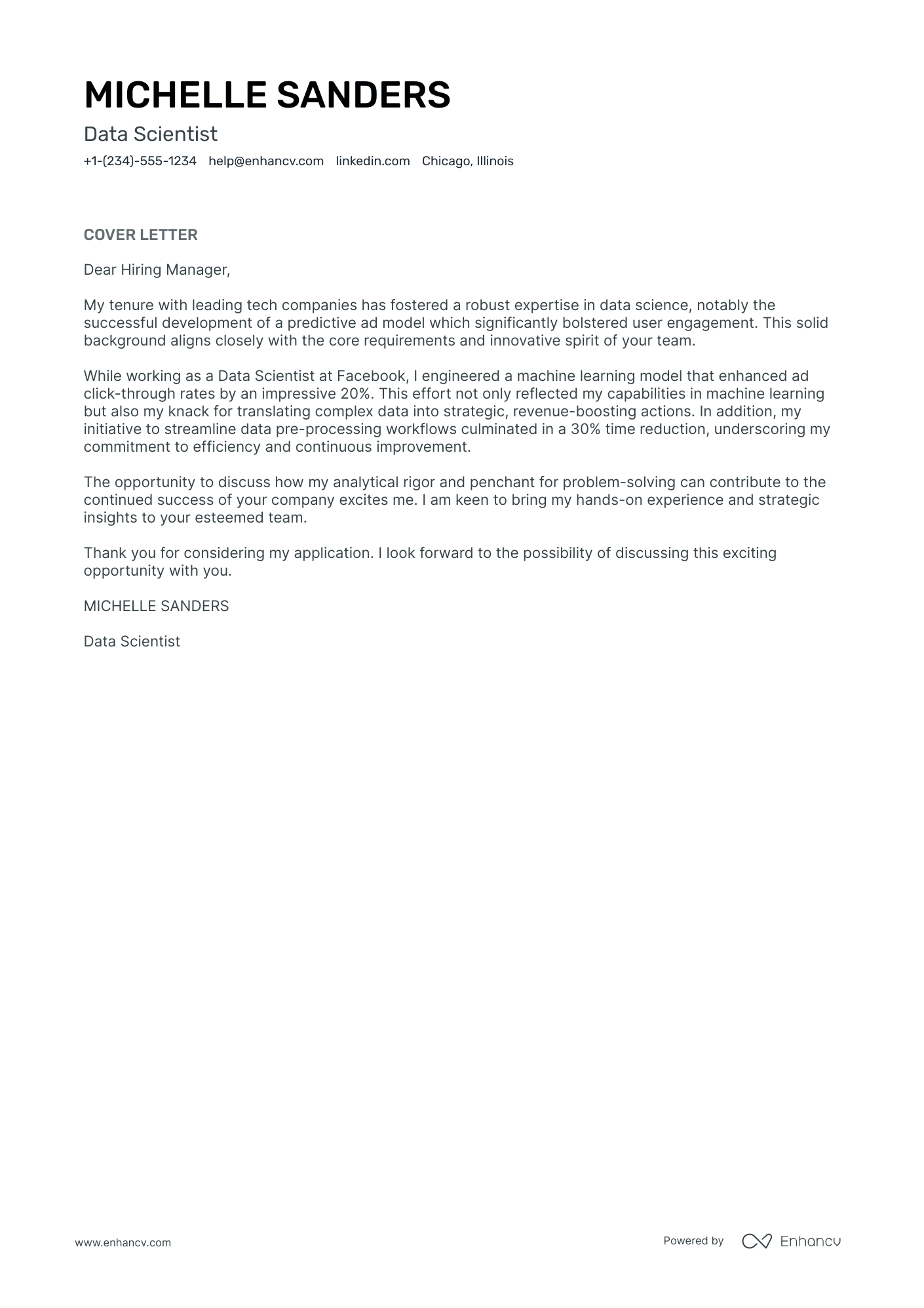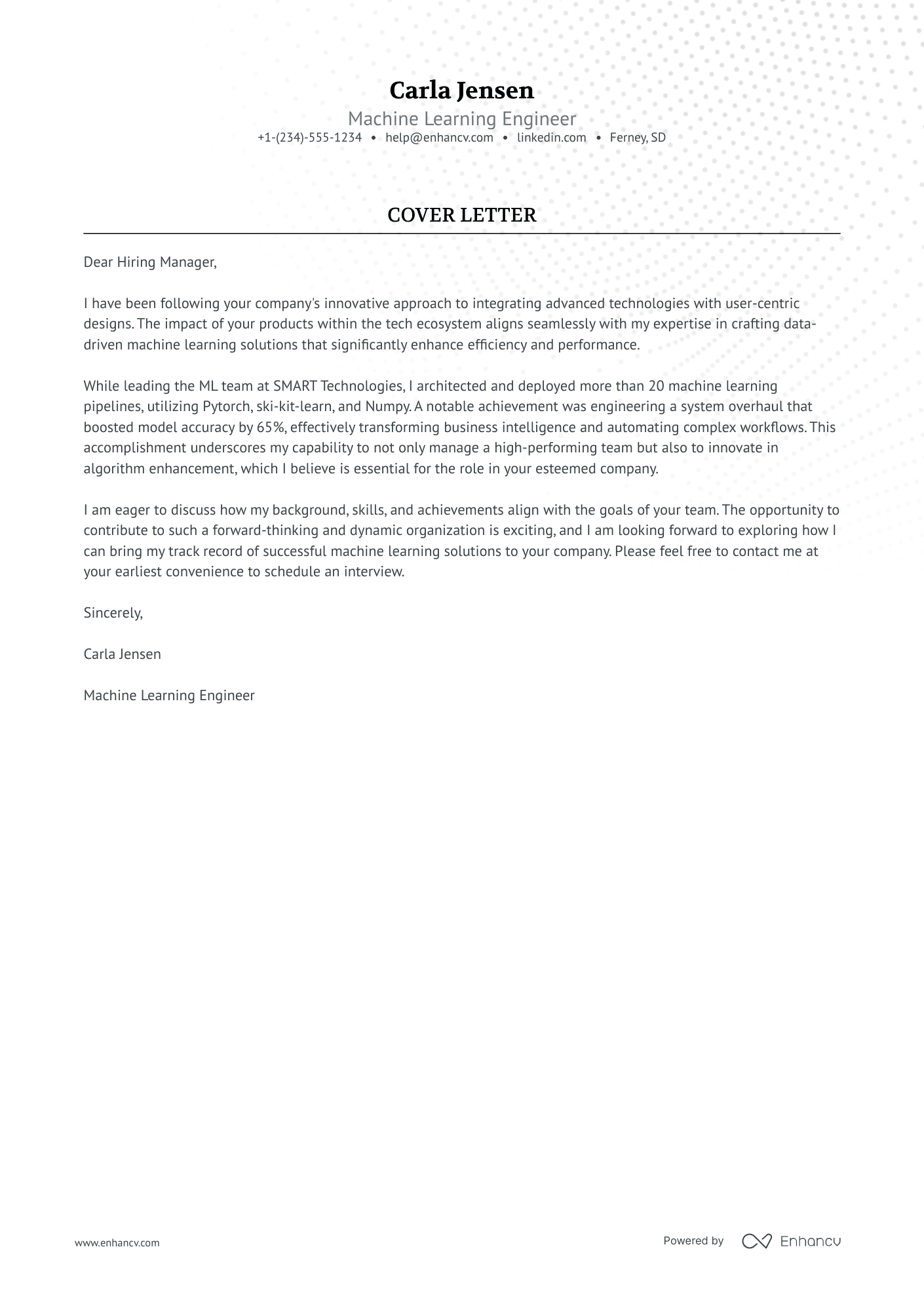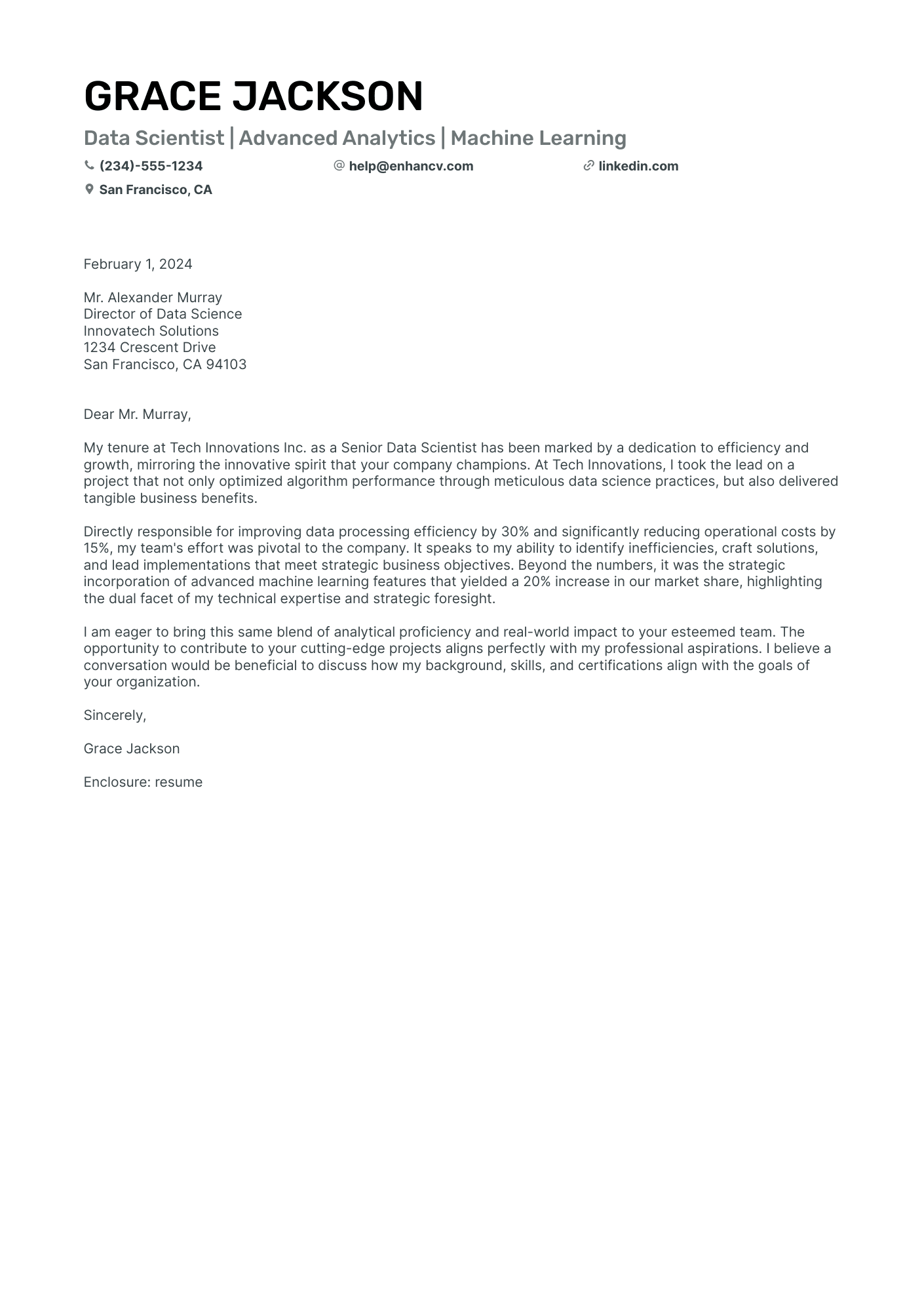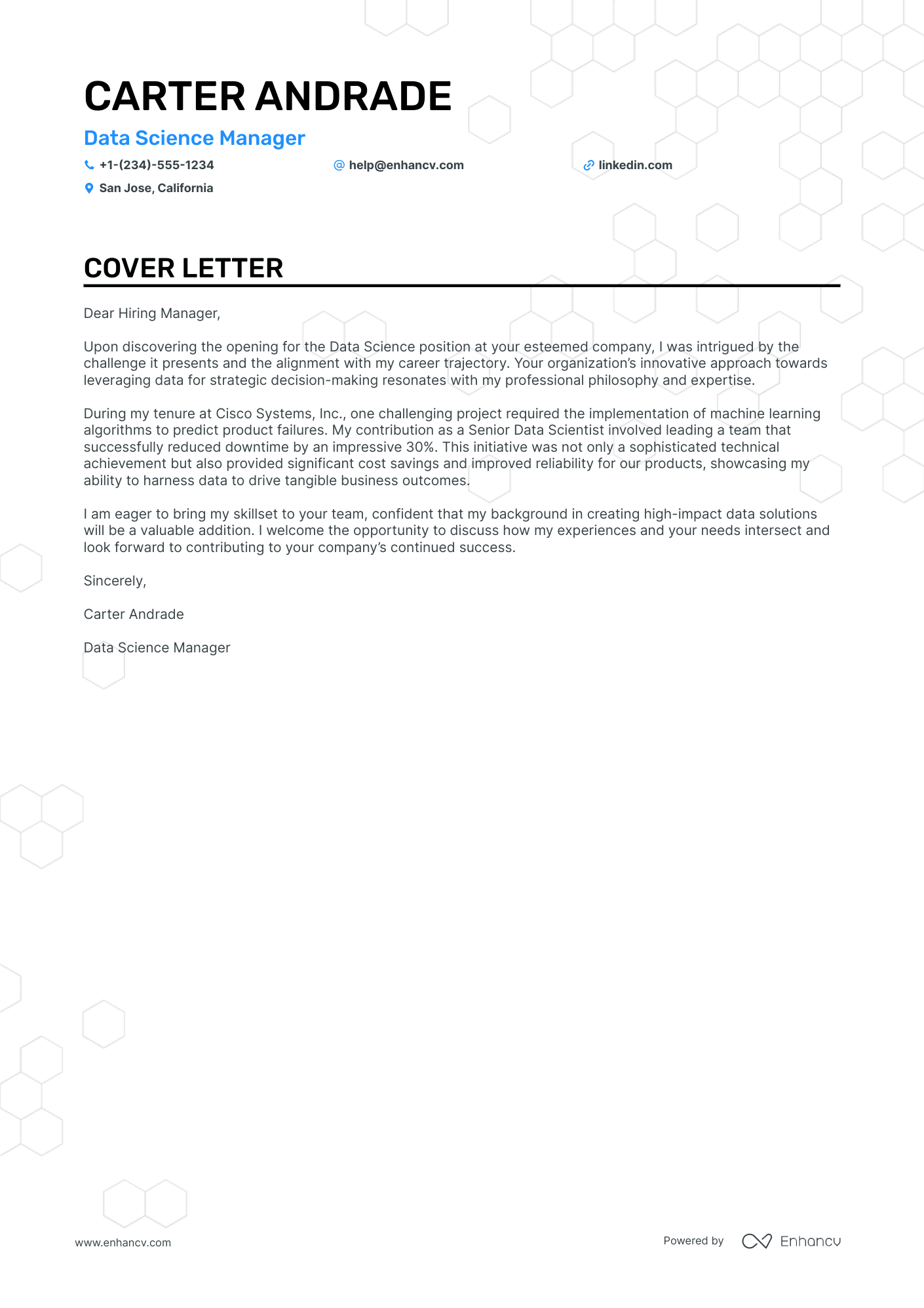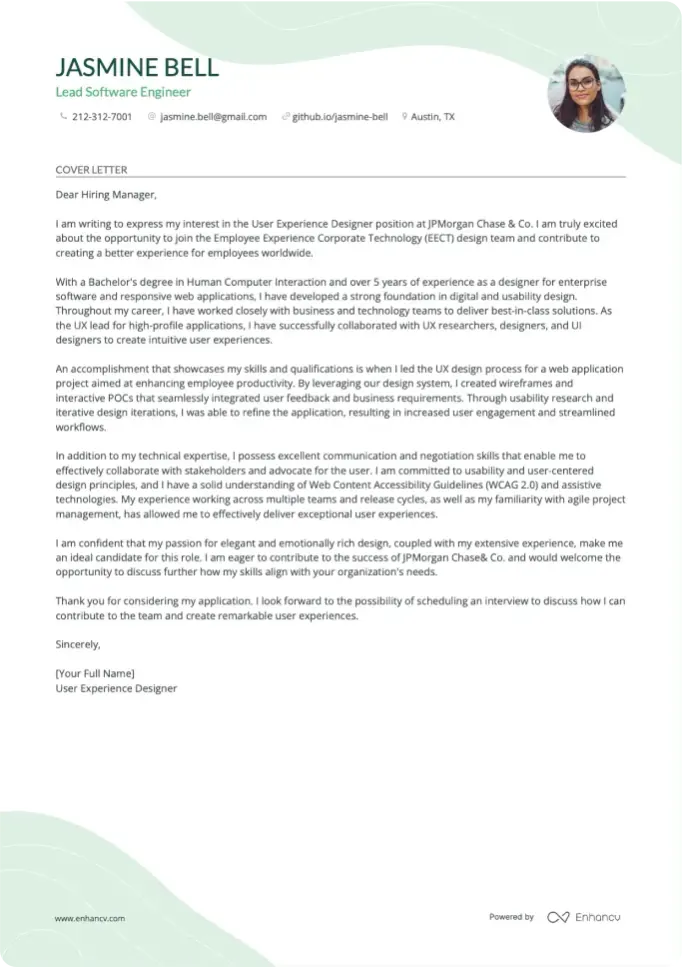Crafting the perfect data scientist cover letter can be a puzzling task when you're deep in the job hunt. You've been submitting applications and suddenly hit the cover letter hurdle – it's not just a repeat of your resume but a snapshot of your crowning professional achievement. In this guide, we'll show you how to weave in your triumph without drowning in clichés or penning a novel. Keep it concise, captivate with clarity, and let your story shine on just one page.
- Introduce your profile to catch recruiters' attention;
- Use professional templates and examples to make sure your data scientist cover letter follows the best industry standards;
- Settle on your most story-worthy achievement to shine a light on what makes your application unique;
- Write a data scientist cover letter, even when you lack professional experience.
Ready to start with the basics: upload your resume to Enhancv's AI, below, to see the data scientist cover letter it would write for you.
If the data scientist isn't exactly the one you're looking for we have a plethora of cover letter examples for jobs like this one:
- Data Scientist resume guide and example
- Data Warehouse Architect cover letter example
- Junior Data Analyst cover letter example
- Database Architect cover letter example
- Data Science Manager cover letter example
- Data Engineer cover letter example
- Statistical Data Analyst cover letter example
- Healthcare Data Analyst cover letter example
- Data Analytics Manager cover letter example
- Data Specialist cover letter example
- Data Entry Clerk cover letter example
Drop your resume here or choose a file.
PDF & DOCX only. Max 2MB file size.
Data scientist cover letter example
Charlotte May
Phoenix, AZ
+1-(234)-555-1234
help@enhancv.com
- Illustrate previous success with concrete results: The cover letter highlights a key achievement at Dell, where a revamp of the digital marketing strategy led to a 50% improvement in campaign performance and a 250% spike in revenue from search marketing campaigns, which shows the candidate's ability to drive substantial business outcomes.
- Match skills to job requirements: The cover letter mentions specific expertise in machine learning and data analytics, aligning directly with the skills sought in a data scientist role, signaling the candidate's suitability for the technical aspects of the job.
- Show strategic impact: The candidate emphasizes their ability to not just analyze data but also make strategic recommendations, showing that they have a broader vision for how data science can influence and grow the business.
- Express eagerness to contribute to the company's success: The cover letter stresses the candidate's enthusiasm to bring their track record to the new company, indicating a future-focused, proactive mindset that is likely to resonate with the hiring manager.
The format of your data scientist cover letter: structure, fonts, margins, and more
Your data scientist cover letter should include a header (with your name, position, and date); a greeting and introductory paragraph; a body and closing paragraphs; and an optional signature.
Remember that you're writing your data scientist cover letter for recruiters - as the Applicant Tracker System won't scan this content.
Here are a few more tips and tricks to keep in mind when formatting your data scientist cover letter:
- Use the same font in your data scientist cover letter and resume. We recommend modern fonts, e.g. Lato and Rubik, to help you stand out, instead of the stereotypical Arial and Times New Roman.
- Each paragraph should have single spacing, which is already set up for you in our cover letter templates.
- Our cover letter builder follows industry standards for your data scientist cover letter formatting - with a one-inch margin, surrounding your content.
- Always export your data scientist cover letter in PDF to ensure the image or text quality stays the same and your writing isn't moved about.
Overwhelmed by cover letters? Our free cover letter generator lets you make one in seconds based on your resume.
The top sections on a data scientist cover letter
- Header: Includes full name, address, phone number, email, and date, setting a professional tone and providing the recruiter with essential contact information.
- Greeting: Addresses the hiring manager or recruitment team by name if possible, demonstrating attention to detail and personalized communication, which reflects a data scientist's precision.
- Introduction: Briefly summarizes the candidate's background in data science, stating the intention to apply and a hook on why they're a good fit, piquing the recruiter's interest.
- Experience and Skills: Highlights relevant data science projects, technical skills like programming languages and statistical analysis, and problem-solving experiences that are critical for the role.
- Closing and Call to Action: Reiterates interest in the position, invites the recruiter to review the attached resume, and suggests a meeting or interview, showing proactiveness and enthusiasm for the role.
Key qualities recruiters search for in a candidate’s cover letter
- Proficiency in programming languages such as Python or R: Necessary for writing scripts to manipulate data and build statistical models.
- Mastery of data wrangling and preprocessing: Ensures the candidate can efficiently clean and organize raw data for analysis.
- Experience with machine learning algorithms and statistical analysis: Demonstrates the ability to apply advanced techniques to extract insights from data.
- Familiarity with data visualization tools (e.g., Tableau, PowerBI) and libraries (e.g., Matplotlib, Seaborn): Important for communicating findings effectively to stakeholders.
- Knowledge of big data platforms (e.g., Hadoop, Spark): Shows that the candidate can work with large datasets and understands the technical challenges involved.
- Strong problem-solving skills and business acumen: Indicates the ability to understand business problems and provide actionable data-driven insights.
How to start your data scientist cover letter: with a greeting, of course
Have you ever considered just how powerful a personalized salutation can be?
We sure have news for you! Your data scientist cover letter should start with the right salutation to recruiters, nurturing a sense of respect and individuality.
Greet recruiters by using their first name (e.g. "Dear Tom" or "Dear Patricia") if you've previously established contact with them.
Otherwise, opt out for the less familiar, "Dear Ms. Peaches" or "Dear Ms Kelsey", if you've found the recruiter's name on LinkedIn or a corporate website.
"To whom it may concern" is never a good option, as it creates a sense that you've been sending out your data scientist cover letter to anyone. Instead, use "Dear HR team" or "Dear (company name) recruiter" for a feeling of exclusivity.
List of salutations you can use
- Dear Hiring Manager,
- Dear [Company Name] Recruiter,
- Dear [Department] Team,
- Dear Mr./Ms. [Last Name],
- Dear Dr. [Last Name],
- Dear Search Committee,
How to start your data scientist cover letter introduction
The opening paragraph of your data scientist cover letter can seem like a real enigma.
Where do you start writing?
In your data scientist cover letter introduction, focus on yourself by stating what:
- gets you motivated and excited about the role;
- you like best about the company, from culture to awards.
Write no more than two sentences, which are both authentic and show your enthusiasm for the opportunity.
Structuring your data scientist cover letter body to add more value
You've hinted at your value as a professional (this may be your passion for the job or interest in the company) in your introduction.
Next, it's time to pan out the body or middle of your data scientist cover letter.
When creating your resume, you've probably gone over the advert a million times to select the most relevant skills.
Well, it's time to repeat this activity. Or just copy and paste your previous list of job-crucial requirements.
Then, select one of your past accomplishments, which is relevant and would impress hiring managers.
Write between three and six paragraphs to focus on the value your professional achievement would bring to your potential, new organization.
Tell a story around your success that ultimately shows off your real value as a professional.
Finishing off your data scientist cover letter with what matters most
So far, you've done a fantastic job in tailoring your data scientist cover letter for the role and recruiter.
Your final opportunity to make a good impression is your closing paragraph.
And, no, a "Sincerely yours" just won't do, as it sounds too vague and impersonal.
End your data scientist cover letter with the future in mind.
So, if you get this opportunity, what do you plan to achieve? Be as specific, as possible, of what value you'd bring to the organization.
You could also thank recruiters for their interest in your profile and prompt for follow-up actions (and organizing your first interview).
Is it beneficial to mention that you have no experience in your data scientist cover letter?
Lacking professional experience isn't the end of the world for your data scientist cover letter.
Just be honest that you may not have had roles in the industry, but bring about so much more.
Like, your transferable skills, attained thanks to your whole work and life experience (e.g. the skills your summer spent working abroad taught you).
Or, focus on what makes you, you, and that one past success that can help you stand out and impress recruiters (think of awards you've attained and how they've helped you become a better professional).
Alternatively, write about your passion and drive to land the job and the unique skill set you would bring to enhance the workplace culture.
Key takeaways
Within this Enhancv guide, we've provided you with plenty of advice and inspiration on writing your data scientist cover letter:
- Always make sure your data scientist cover letter is tailored to the role you're applying for to make a good impression on recruiters;
- In your data scientist cover letter include a header (with your name, the role you're applying for, date, and contact details) and an introduction of up to two sentences that highlight your key accomplishment or why you'd fit the role;
- Focus your data scientist cover letter body on one sole achievement through your career and all the valuable lessons, skills, and know-how you've learned (that are relevant to the role);
- Ensure your data scientist cover letter closing statement isn't generic and includes either a call to action or a promise;
- If you lack professional experience, shift recruiters' focus to a relevant achievement (thanks to your academic or versatile experience) or toward your dreams and goals for professional growth.
Data Scientist cover letter examples
By Experience
Data Science Intern
Entry-Level Data Scientist
Senior Data Scientist
By Role
